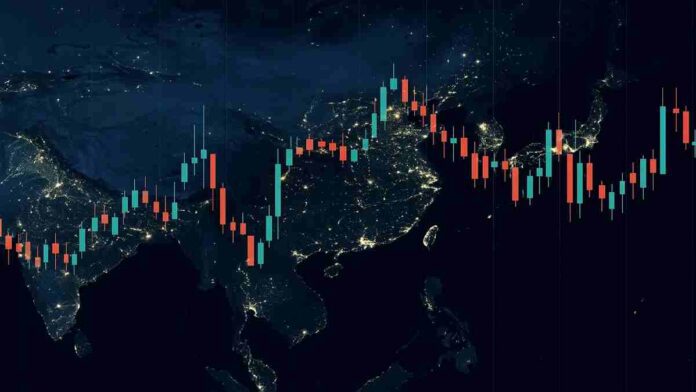Asian Markets Closing Bell; Hang Seng Leads Decline Amid Tariff Concerns
Note: This analysis covers the close of the Asian trading session. Event times are in US Eastern Time.
Asian Indices Performance at Close
| Index | Price | Daily Change (%) |
|---|---|---|
| Shanghai Composite | 3889.50 | -0.19 |
| Nikkei 225 | 48088.80 | -1.01 |
| Hang Seng Index | 25889.48 | -1.52 |
| Shenzhen Component | 13231.47 | -0.93 |
| KOSPI | 3584.55 | -0.72 |
| S&P/ASX 200 | 8882.80 | -0.84 |
| NIFTY 50 | 25227.35 | -0.23 |
| Straits Times Index | 4389.84 | -0.84 |
| S&P/NZX 50 | 13351.92 | -0.86 |
| FTSE Bursa Malaysia KLCI | 1615.19 | -0.44 |
| TAIEX | 26923.42 | -1.39 |
Market Commentary
In today’s Asian session, market sentiment turned cautious as investors grappled with a mix of economic data and geopolitical tensions, leading to a generally negative performance across major indices.
Key market drivers included renewed concerns over U.S.-China trade relations, particularly in light of recent reports suggesting a potential revival of tariffs by the U.S. This backdrop weighed heavily on investor sentiment, particularly in China, where the Shanghai Composite fell by 0.19%. Despite this, analysts from Soochow Securities indicated that the ongoing rally in Chinese stocks may persist, reflecting a degree of resilience amidst external pressures.
The Nikkei 225 in Japan declined by 1.01%, influenced by a stronger yen and concerns surrounding the global economic outlook. Similarly, the Hang Seng Index in Hong Kong experienced a significant drop of 1.52%, reflecting the ongoing struggles in the local food and beverage sector, exemplified by the closure of a prominent cafe chain amid tough market conditions.
In South Korea, the KOSPI fell by 0.72%, exacerbated by the ongoing depreciation of the won against the U.S. dollar, which has breached the 1,400 won threshold. This currency pressure is compounded by stalled currency swap talks with Washington, leaving market participants wary of further declines.
Australia’s S&P/ASX 200 also faced challenges, closing down 0.84%, as the country moves to bolster its critical minerals strategy in response to geopolitical tensions. Meanwhile, the NIFTY 50 in India and the Straits Times Index in Singapore both recorded slight declines of 0.23% and 0.84%, respectively, reflecting broader regional trends.
Overall, the Asian markets closed lower, driven by a mix of geopolitical uncertainties and domestic economic challenges. The prevailing sentiment remains cautious, with investors closely monitoring developments in trade relations and currency fluctuations as they navigate this complex landscape.
FX, Commodities, and Cryptocurrencies
In the FX market, the USD/JPY rose by 0.42%, while the AUD/USD experienced a notable increase of 0.73%. Conversely, the USD/NZD and USD/INR saw slight declines of -0.16% and -0.08%, respectively. In the cryptocurrency sector, Bitcoin gained 0.30%, reaching a price of $115,442.12, while Ethereum’s price increased marginally by 0.05% to $4,161.37. No data was available for commodities. Overall, the FX market exhibited mixed performance, with some currencies strengthening against the USD, while cryptocurrencies showed modest gains.
Currency Pairs
| Currency Pair | Price | Daily Change (%) |
|---|---|---|
| USD/JPY | 152.22 | 0.42 |
| USD/CNY | 7.13 | 0.10 |
| USD/SGD | 1.30 | 0.17 |
| AUD/USD | 0.65 | 0.73 |
| USD/NZD | 1.74 | -0.16 |
| USD/INR | 88.62 | -0.08 |
Cryptocurrencies
| Crypto | Price | Daily Change (%) |
|---|---|---|
| Bitcoin | 115442.12 | 0.31 |
| Ethereum | 4161.37 | 0.05 |
Economic Events During Asian Session
The following economic events occurred during the Asian session (yesterday 17:00 to today 03:30 US Eastern Time):
| Date | Time | Cur | Imp | Event | Actual | Forecast |
|---|---|---|---|---|---|---|
| 2025-10-12 | 23:30 | 🇨🇳 | Medium | Exports (YoY) (Sep) | 8.3% | 6.0% |
| 2025-10-12 | 23:30 | 🇨🇳 | Medium | Imports (YoY) (Sep) | 7.4% | 1.5% |
| 2025-10-12 | 23:30 | 🇨🇳 | Medium | Trade Balance (USD) (Sep) | 90.45B | 98.50B |
In September, China’s economic data revealed stronger-than-expected trade performance, impacting market sentiment positively. Exports rose by 8.3% year-on-year, significantly surpassing the forecast of 6.0%, indicating robust global demand for Chinese goods. Similarly, imports increased by 7.4%, well above the anticipated 1.5%, suggesting a rebound in domestic consumption and industrial activity. However, the trade balance recorded a surplus of $90.45 billion, falling short of the forecasted $98.50 billion. This discrepancy may raise concerns about the sustainability of the trade surplus amid rising imports. Overall, the stronger export and import figures could bolster investor confidence in China’s economic recovery, potentially leading to a positive reaction in Asian markets, particularly in sectors reliant on trade. However, the lower-than-expected trade balance might temper enthusiasm, prompting a cautious approach among investors as they assess the implications for future economic policies.




